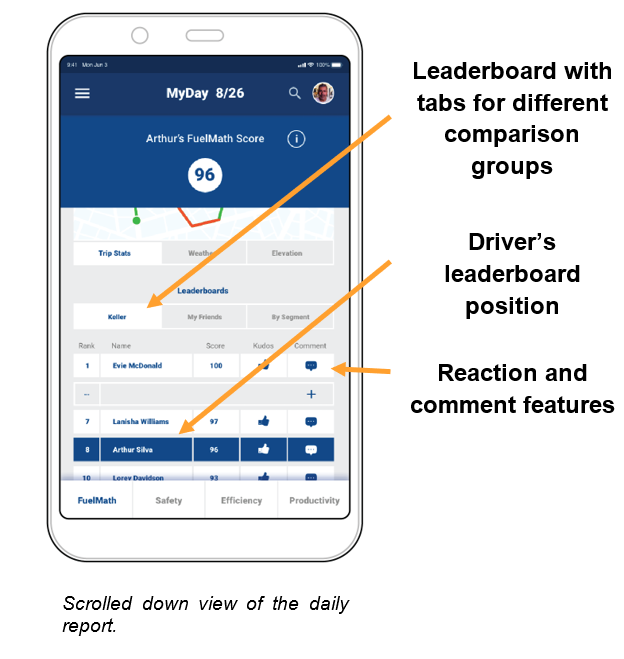It would take planting over half a billion acres of forest to offset the amount of CO2 emitted in a year by trucks in the United States. In 2018 alone, medium- and heavy-duty U.S. trucks consumed 43.6 billion gallons of fuel. In the same year, transportation was the highest producer of U.S. greenhouse gas emissions, a trend largely driven by trucks.
Driving “over-the-road” takes its toll, too. Trucking is the seventh deadliest occupation in the United States, after occupations such as fishing and hunting, logging and piloting aircraft. You might find yourself driving more than 500 miles a day and spending as many as 65 hours a week on the road. You can go for days, weeks or months without seeing family and friends. Sitting all day with limited access to nutritious food, it’s hard to stay healthy. To top it all off, many drivers have a difficult relationship with company management. Turnover is incredibly high – 73% of employees leave small companies within a year, and the number rises to 89% for companies with larger fleets.
You just drive, sleep, drive, sleep. Companies don’t treat you like a human. You are just a machine that makes money for them.”
Driver Donna Penland, quoted in the Washington Post.
The Behavioral Insights Team recently partnered with LinkeDrive – an industry leader in truck driver performance management – to identify ways to use behavioral insights to help truck drivers drive more safely and fuel-efficiently, while also improving drivers’ experience on the road. LinkeDrive uses real-time data to provide drivers with live feedback and motivational coaching, encouraging safer and more fuel-efficient driving. Over the last few months, we’ve reviewed the literature and spoken to truck drivers and fleet managers across the country. This year, in partnership with LinkeDrive and a commercial trucking company, we will test these recommendations in what we believe will be the first large-scale field trial in this space.
So, what have we learned so far?
1. Provide drivers with easy-to-understand, personalized feedback
We identified a simple reason it can be difficult to drive safely and fuel-efficiently: drivers may not know how to drive safely and fuel-efficiently. The process of trial and error, which is critical to learning, simply doesn’t work if you can’t see how your actions influence key outcomes like fuel consumption and safety. For example, drivers might ask themselves what makes more of a difference – monitoring my acceleration or using cruise control? How does my harsh braking compare to other drivers’? Without specific, timely information it’s difficult to know how to improve.
A field experiment with Virgin Atlantic Airways has suggested some strategies for helping transport professionals improve their performance. Here researchers sent pilots monthly feedback reports that shared how often they engaged in fuel-efficient behaviors and gave them personalized efficiency targets. They found these solutions, among others, helped pilots improve their efficiency, and saved between 838,000-2.22 million kg of CO2 in the process.
Our solution
Make feedback timely, specific, and personal to help drivers improve their skills.
LinkeDrive’s PedalCoach app already provides drivers with immediate feedback on how fuel-efficiently they’re driving. Simplified, end-of-day reports can help drivers understand what went well in that day’s drive, and what could have gone better. Weekly and monthly reports can help drivers track their progress over time, as well as sharing one skill to work on that month.
Figure 1. BIT mock-up of a simplified end-of-day report

2. Tell drivers how their peers are doing
People tend to improve their performance when they learn how they stack up against their peers – a concept known in behavioral science as relative rank. Many fitness apps like Strava and Fitbit leverage this insight to encourage users to run another mile or take some extra steps. Spotify also tells listeners how their activity compares to others (“You were in the top 3% of Taylor Swift listeners”), and encourages them to share their stats on social media.
Research has found these comparisons are most effective when:
- We are compared to those we perceive to be similar to ourselves;
- We are compared on criteria we care about;
- We are close to a cut-off (such as the top or bottom of a list);
- We have an audience.
Our solution
LinkeDrive’s leaderboards can be made even more effective by allowing drivers to compare themselves to peers, such as drivers with the same type of truck, similar loads, or comparable routes. Integrating social features, where drivers in the same company can react to and comment on each others’ scores could increase the sense of competition.
Figure 2. BIT mock-up of a behaviorally-informed leaderboard

Ultimately, transportation, specifically truck driving, is an area ripe for behavioral intervention. Harnessing an understanding of human behavior through easy-to-understand, personalized and social feedback could improve both fuel-efficiency and safety on US roads and truck driver health. We look forward to sharing an update after we test some of these ideas in the field. For more information on this project, please contact BIT.





